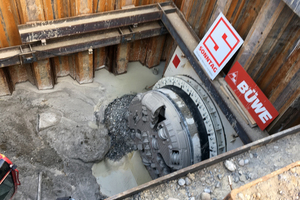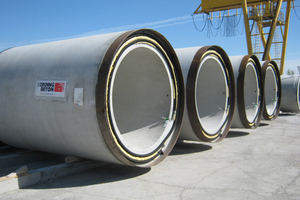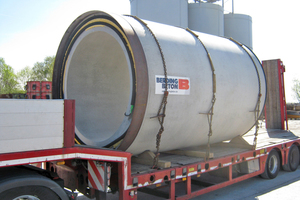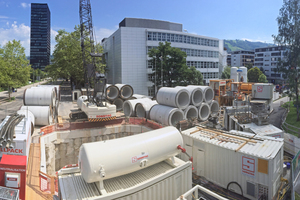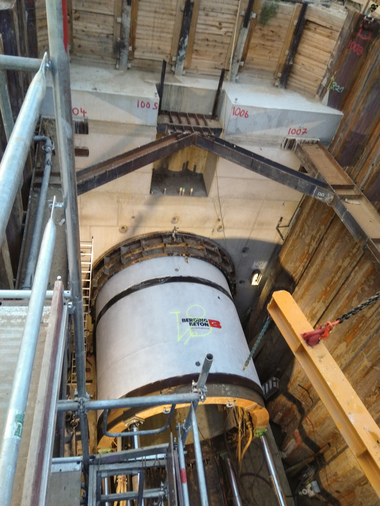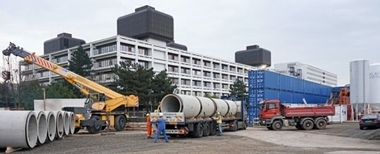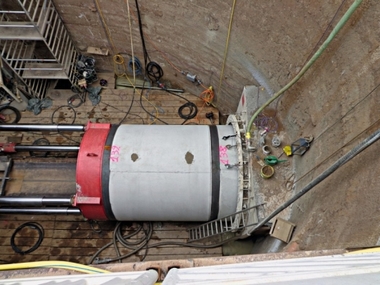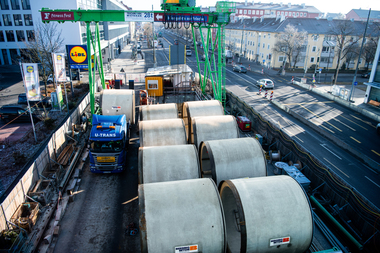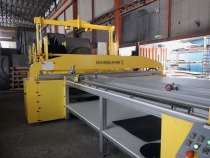760 jacking pipes for urban drainage installed in Zug
Following a long planning and construction phase, the construction department in the Swiss city of Zug can now announce successful completion of the Lake Zug Outfall Pipeline project in the northern part of the city. The WWZ energy supply company applied microtunneling technology not only for a new stormwater relief sewer, but also for an innovative district heating pipeline. Since 1995, the city of Zug, within the scope of a General Drainage Plan (GEP), has been continuously converting a combined sewer system into a separated system. By now, more than two thirds of Zug network consist of such separated system. This separation relieves the sewage treatment system by draining the stormwater separately from the sewage, which reduces the danger of flooding and improves the quality of the water in Lake Zug.
In the course of the drainage project, a new Meteor water pipeline, currently around 1,800 m long, has been installed in the north of the city and is scheduled to be put into operation in the autumn of 2018. The new main pipeline conducts rainwater in three pipe sections from the densely populated north into Lake Zug. The project is currently one of the largest of its kind in Europe, with the entire pipeline being constructed by microtunneling. This underground construction method offers the advantage that essentially only launch and receive pits are required for its implementation, obviating the need for ripping open complete roads. This method, moreover, is much more cost-efficient, apart from reducing the necessary traffic restriction to a minimum.
Berding Beton delivered reinforced-concrete pipes
Concurrently with the construction of the stormwater relief sewer, the energy supplier WWZ in Zug developed a second project by the name of Circulago. The energy from Lake Zug is utilized by employing an energy cycle below the city to deliver hot and cold energy for the city of Zug and the neighboring community of Baar-Süd. The 1-km district heating pipeline required for this innovative heating system was constructed by the microtunneling method as well.
The company Sonntag Bau-gesellschaft mbH & Co. KG, specialized in pipe jacking and sewer construction, was responsible for professional implementation of the entire project. A total of five shafts were constructed at depths that partly extended below the groundwater. To ensure safe and reliable work to be carried out on this substructure, concrete slabs 2 m thick were manufactured to serve as foundation for the jacking machines. The cutter head of the jacking machine subsequently inched its way through the ground for installing the pipelines, with their overall length of around 2,800 m.
The high-quality reinforced-concrete jacking pipes were delivered by Berding Beton GmbH, a specialist in this field. Pipe elements 4 m long with an interior diameter of DN 2000 mmm and an outer diameter of DA 2680 mm were used. The reinforced concrete pipes weighed in at 25 metric tons each.
Up to 50 pipe elements in one week
For the innovative WWZ district-heating pipeline, likewise constructed by unmanned jacking, 270 Berding concrete jacking pipes with ID 1600 mm and OD 1960 mm were installed.
The jacking pipes were manufactured in conformity with quality standards DIN EN 1916 and DIN V 1201, as well as the Swiss standard SIA 195. Berding, in addition to observing its own high-quality standards, was required to satisfy specific technical requirements. One of these stipulations was to use only jacking pipes that hardened in their forms. This ensured high dimensional accuracy and smooth pipe surfaces, and low reduced skin friction during jacking. Technical coordination and optimization of the pipe design proceeded in close collaboration with the company Sonntag and the Swiss firm Jackcontrol. The latter offers a system for pressure transfer by means of a so-called hydraulic joint during jacking: i.e., with filled hydraulic hoses. The special design of the hoses ensures at close radii – and therefore wide angles – full pressure transfer between the pipe interfaces in all loading situations that may occur. This enables jacking of long lengths, even in the presence of very tight radii. To implement this sophisticated pressure transfer system, the high-quality jacking pipes were fitted with hydraulic hoses supplied by the company Jackcontrol and then delivered ready-to-install to the construction site. Up to 50 pipe elements per week were transported to the construction site – owing to their dimensions, in some cases individually by semi-trailer. In addition, it was necessary to have in readiness all necessary documents for correct customs clearance. A total of 573 transports took place during the entire construction project, during which around 13,500 tons were moved.
During the five stages, it was sometimes necessary to negotiate curves with radii of R ≥ 250 to R ≥ 700 m in the horizontal and vertical. The longest distance that the cutting head had to travel in one section measured 890 m and ran from the north of the city to the south. Installation took place of a total of 760 jacking pipes, whose useful life ranges from 80 to 100 years. Work began in August 2017 and was successfully completed on schedule in April 2018.

